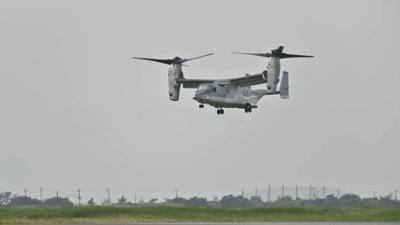Casualties Reported Likely
A Bell Boeing V-22 Osprey tilt-rotor aircraft reportedly belonging to and operated by the United States Marine Corps went down off the coast of the northern-Australian city of Darwin during a training exercise. The V-22, according to sources within the Australian Defense Forces, was carrying some twenty U.S. Marines.

Australian news outlets reported the accident occurred in the vicinity of Melville Island—a sizable Timor Sea landmass approximately 27-nautical-miles north of Darwin’s city-center—during so-called Predator Run drills involving personnel of the U.S. Marine Corps and the Australian, Indonesian, Philippine, and Timor-Leste Defense Forces.
Sources with knowledge of the mishap state casualties resultant of such are “possible” insofar as a number of Marines remain unaccounted for.
In a statement, the Australian Defense Forces set forth: "Initial reports suggest the incident involves United States defense personnel and that the Australian Defense Force members were not involved.”
The report continued: “At this critical early stage, our focus is on the incident response and ensuring the safety of those involved. More information will be provided when appropriate."
Air-ambulance aircraft embarking on an ostensible rescue operation have been sighted leaving Darwin airport. Moreover, the Royal Darwin Hospital is reported to be preparing for an influx of victims.
In a brief statement, Northern Territory Police confirmed its personnel are "currently responding to reports of an aircraft crash on Melville Island.”
The Predator Run drills, in which roughly 2,500 military personnel are participating, were paused following the Osprey’s downing.
Born of failure—namely, that of 1980’s Operation Eagle Claw, which occasioned the Pentagon’s realization that military roles exist to which neither conventional helicopters nor fixed-wing aircraft are well-suited—the V-22 has passed its operational life endeavoring to live down the troubled infancy, protracted adolescence, and lofty price tag for which it’s infamous.
The U.S. Department of Defense (DoD) green-lit the V-22 in 1983; a prototype flew in 1989; flight-testing the Osprey, however, spanned a worrying 18-years and entailed numerous, sweeping design alterations. The fourth and fifth V-22 prototypes crashed in 1991–92 respectively. In 2000, during U.S. Naval sea-trials, the Osprey test-fleet was grounded following two fatal accidents that collectively claimed the lives of 23 Marines.
Once operational, the V-22’s lot didn’t much improve. Massive cost overruns prompted repeated Congressional attempts to kill the Osprey program. During a 2000 address before a House of Representatives subcommittee, noted defense industry analyst Michael E. O’Hanlon asserted: “Its [The V-22's] production costs are considerably greater than for helicopters with equivalent capability—specifically, about twice as great as for the CH-53E, which has a greater payload and an ability to carry heavy equipment the V-22 cannot.”
In 2001, Lieutenant Colonel Odin Lieberman, commander of the V-22 squadron at Marine Corps Air Station New River, was relieved of duty amidst allegations that he’d instructed his unit to falsify maintenance records for purpose of making the Osprey appear more reliable.
Between 2007 and 2010, USMC V-22s demonstrated a dismal fleetwide readiness rate of 53-percent. By 2012, the Marine Corps’ V-22 readiness rate had risen to a slightly less dismal 68-percent. Nevertheless, since 2015, V-22s have required more service and posted lower dispatch availability rates (62-percent) than the conventional helicopters operated by the U.S. Air Force, Navy, and Marine Corps.
On 17 August 2022, Lieutenant General Jim Slife of the U.S. Air Force’s Special Operations Command (AFSOC) ordered a fleet-wide safety standdown of AFSOC V-22s in the wake of increasingly frequent instances Hard Clutch Engagement (HCE)—a dangerous and unpredictable phenomenon comprising enormous, often unrecoverable thrust asymmetries attributable to malfunctions of the complex drivetrain by which the V-22’s two Rolls-Royce Liberty AE1107C engines are linked.

On 12 August 2022, a hard clutch engagement forced an AFSOC (U.S. Air Force Special Operations Command) CV-22 Osprey crew to make an emergency landing in a nature preserve on the Norwegian island of Senja. Onsite repairs to the downed aircraft were deemed impossible, and Norwegian authorities—citing the delicacy of the Stongodden nature preserve’s bucolic terrain—balked at the notion of a conventional salvage operation.
Thus began a vexing, eminently 21st Century drama that saw the $90-million tiltrotor sit, idle and moldering, in deference to mosses, lichens, wandering reindeer, and environmental activists. For 46-days the Osprey sat in ignominy—waiting with the infinite, brooding patience of abandoned machines—as Norwegian military and environmental officials concocted a plan by which to remove it from the island, and U.S. Air Force brass pondered and finally approved a rescue operation.
 NTSB Final Report: Evektor-Aerotechnik A S Harmony LSA
NTSB Final Report: Evektor-Aerotechnik A S Harmony LSA ANN's Daily Aero-Term (09.15.25): Decision Altitude (DA)
ANN's Daily Aero-Term (09.15.25): Decision Altitude (DA) Aero-News: Quote of the Day (09.15.25)
Aero-News: Quote of the Day (09.15.25) Airborne 09.12.25: Bristell Cert, Jetson ONE Delivery, GAMA Sales Report
Airborne 09.12.25: Bristell Cert, Jetson ONE Delivery, GAMA Sales Report Airborne 09.10.25: 1000 Hr B29 Pilot, Airplane Pile-Up, Haitian Restrictions
Airborne 09.10.25: 1000 Hr B29 Pilot, Airplane Pile-Up, Haitian Restrictions




